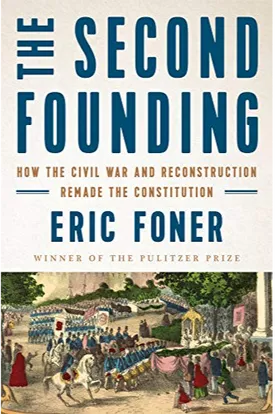The Second Founding: How the Civil War and Reconstruction Remade the Constitution by Eric Foner
In his groundbreaking book “The Second Founding: How the Civil War and Reconstruction Remade the Constitution,” award-winning historian and Pulitzer Prize winner Eric Foner examines the impact of the Civil War, Reconstruction and abolition of slavery on American politics, society and culture. This book offers a comprehensive, yet concise overview of the history of American reconstruction and the socio-economic and political forces that shaped the post-Civil War era, particularly in the South.
Foner begins by exploring the historical context leading up to the Civil War. He discusses the social, political and economic impact of slavery in both the North and the South, and how tensions between the two regions came to a boiling point with the outbreak of the war. He then examines the Reconstruction process and the tensions that still existed between northern and southern states. He provides an in-depth discussion of the constitutional amendments proposed during this time, and the successes and failures of these initiatives in the years that followed.
Foner further explores the impact of the 13th, 14th and 15th Amendments on American politics, society and culture. He explains how the 13th Amendment in particular, which abolished slavery and involuntary servitude, had a revolutionary effect on American society and culture. He notes that while the 13th Amendment was intended to guarantee legal freedom to African Americans, it provided them limited access to political power. The 14th and 15th Amendments, by guaranteeing equal protection and voting rights, provided African Americans with further protection, but unfortunately, these rights were not always respected or enforced.
In the second section of the book, Foner looks at the gradual transformation of the United States from a nation characterized by unity to one divided by class, color and region. He explores how the American economy and the federal government were transformed in the years following the Civil War, and he looks at the effects of Reconstruction on American political and social life. He demonstrates how the Reconstruction era shaped later race relations in the United States by highlighting the persisting power of racial prejudice and the unequal distribution of its effects.
In the third and final chapter of the book, Foner discusses the lasting impact of the Reconstruction era on the Constitution. He demonstrates how the amendments, coupled with civil rights legislation, have drastically altered the composition of the Supreme Court and have paved the way for a different interpretation of the Constitution. He notes that while the alterations have been far-reaching, much more needs to be done to ensure that civil rights are fully respected and enforced in the United States.
“The Second Founding” is an important and illuminating read for anyone interested in the history of Reconstruction and the lasting impact it has had on the Constitution and the nation. Foner provides a detailed overview of the Reconstruction period, emphasizing the successes and failures of the period while exploring the greater transformation of the Constitution and the federal government. With its in-depth exploration of the Reconstruction era, “The Second Founding” is worth reading for anyone interested in American history and the evolution of the Constitution.

